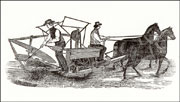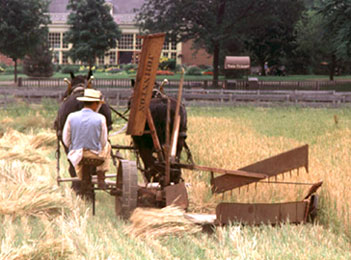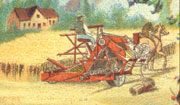 |
|
The Harvest in Great! -- MORE |
|
 "Hand-Rake" Reaper, Seymour & Morgan, 1845. |
Beginning in the 1840s, American farming experienced a mechanical revolution. A farm boy who grew up cutting wheat by hand in the 1830s likely used a horsedrawn reaper in the 1860s. Early reapers cut the grain, and a man rode along and raked the grain off the bed of the reaper with a rake. Laborers gathered it into bundles, called sheaves, which they tied with the long stalks of the grain. Other workers leaned six or more sheaves into each other forming a small a-frame called a shock or stook. The grain was cut slightly green so it did not shatter as it was harvested, and placing it into shocks facilitated drying until it could be threshed. By 1854, a number of companies sold reapers with a raking mechanism to automatically rake the grain off the cutting bed of the reaper. The final improvement on reapers was the "twine binder," a self-binding harvester, marketed in 1879. This machine had a mechanism to tie the grain into sheaves. Workers still had to place it into shocks. At Firestone Farm, an 1880s living history farm demonstration in Greenfield Village, the farm staff use a Johnston self-raking reaper. Founded in Syracuse, New York, by 1890 the company relocated to Batavia, New York, and supplied reapers to farmers around the world. The Firestone Farm wheat is usually harvested in late June or early July, and the farm staff can be just as anxious as farmers of the 1800s. Farmers in the Midwest snatched up these labor saving machines, but over time reapers and binders were replaced by combines. These machines cut and threshed the grain simultaneously. Combines have been the dominant harvest technology since the 1950s. It is hard to imagine what will replace them.
|
| Copyright © The Henry Ford ~ http://www.TheHenryFord.org |



